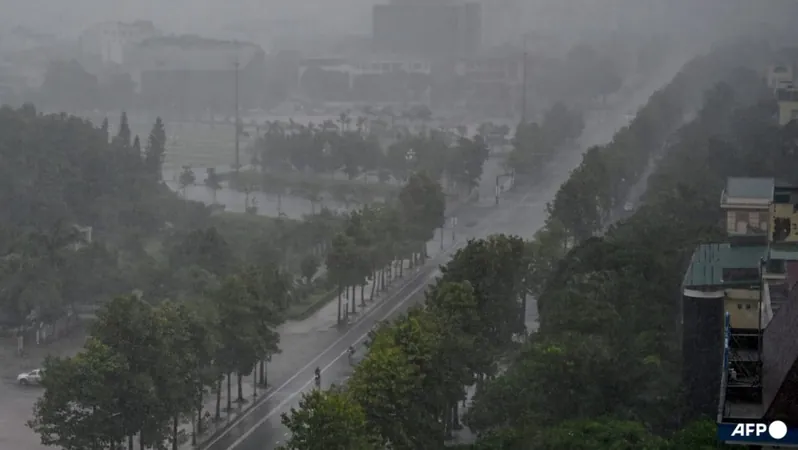
Typhoon Kajiki Hits Vietnam: A Storm of Destruction and Displacement
2025-08-25
Author: Sarah
Nature's Wrath: Typhoon Kajiki Unleashed on Vietnam
On August 25, Typhoon Kajiki slammed into Vietnam's north central coast with catastrophic force, bringing torrential rains that uprooted trees and flooded neighborhoods, even as wind speeds decreased from earlier highs.
By 4 PM local time, Kajiki was battering the coasts of Nghe An and Ha Tinh provinces, with wind speeds dropping to between 118 and 133 km/h, down from a staggering 166 km/h. This ferocity was chilling, as local resident Dang Xuan Phuong described the chaos in Cua Lo, a popular tourist town. "When I looked from my window, I saw waves towering over two meters high, and the roads around us were submerged," he recounted.
A Community in Crisis
Reports from state media revealed widespread devastation: power outages, roofs torn from houses, and floating fishing farms swept away into the turbulent waters. In anticipation of the storm's fury, Vietnamese authorities had already closed airports and schools and started large-scale evacuations, preparing for the most powerful storm of the year.
Officials had warned citizens of an "extremely dangerous fast-moving storm" capable of unleashing severe rains, flooding, and landslides. With its lengthy coastline along the South China Sea, Vietnam frequently faces such storms, which often result in tragic flooding and landslides.
Mass Evacuations and Emergency Response
The weather forecast predicted rainfall could soar to 500mm in parts of northern Vietnam from Monday afternoon through Tuesday's end. In light of this grave situation, around 30,000 residents from vulnerable coastal areas were evacuated. Over 16,500 soldiers and 107,000 paramilitary forces were mobilized to assist with evacuations and prepare for rescue operations.
First-Hand Accounts of Fear and Resilience
Evacuee Nguyen Thi Nhan, 52, expressed disbelief at the sheer scale of the storm: "We've seen storms before, but never anything like this." Le Manh Tung, 66, echoed her sentiments while sheltering in an indoor sports facility in Vinh city, where families relied on simple meals of sticky rice. "I'm scared, but this is nature's doing. We have to accept it," he stated.
Comparisons to Past Disasters
This disaster follows Vietnam's experience last September, when Typhoon Yagi caused $3.3 billion in economic losses and resulted in hundreds of fatalities. In preparation for Kajiki, local air travel was severely disrupted, with two airports in Thanh Hoa and Quang Binh provinces ceasing operations and numerous flights canceled.
Storm's Path and Impact Beyond Vietnam
Kajiki had skirted the southern coast of China's Hainan Island just before making landfall in Vietnam, prompting Sanya City to shut down businesses and public transport. As the storm downgraded, authorities warned of heavy rains and possible secondary disasters across several provinces in southern China, from Sichuan to Heilongjiang.
In the wake of the storm, the Chinese embassy in Hanoi urged its citizens living in Vietnam to remain alert and prepare for continued severe weather. Not only did Typhoon Kajiki wreak havoc in Vietnam, but its effects resonated across borders, drawing international attention to the severe challenges these regions face against the wrath of nature.



 Brasil (PT)
Brasil (PT)
 Canada (EN)
Canada (EN)
 Chile (ES)
Chile (ES)
 Česko (CS)
Česko (CS)
 대한민국 (KO)
대한민국 (KO)
 España (ES)
España (ES)
 France (FR)
France (FR)
 Hong Kong (EN)
Hong Kong (EN)
 Italia (IT)
Italia (IT)
 日本 (JA)
日本 (JA)
 Magyarország (HU)
Magyarország (HU)
 Norge (NO)
Norge (NO)
 Polska (PL)
Polska (PL)
 Schweiz (DE)
Schweiz (DE)
 Singapore (EN)
Singapore (EN)
 Sverige (SV)
Sverige (SV)
 Suomi (FI)
Suomi (FI)
 Türkiye (TR)
Türkiye (TR)
 الإمارات العربية المتحدة (AR)
الإمارات العربية المتحدة (AR)